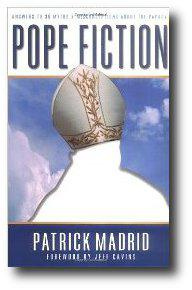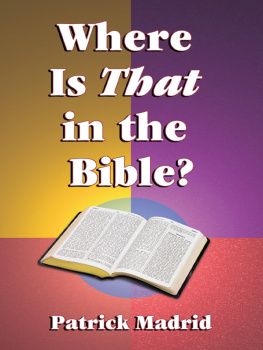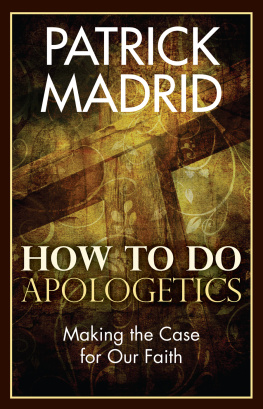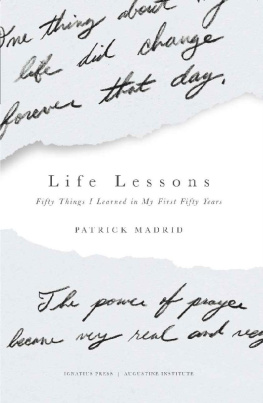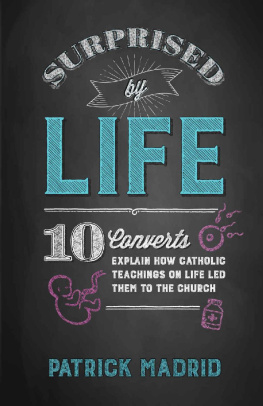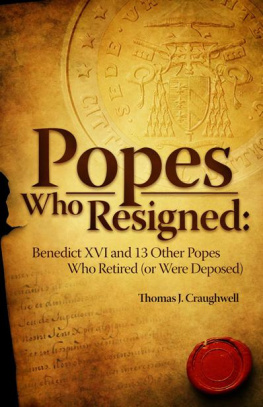Pope Fiction

Patrick Madrid
Contents
Copyright 1999 Basilica Press
Reprint 2005
All rights reserved
Published by Basilica Press 111 Ferguson Court Suite 102 Irving, TX 75062
Except for brief excerpts in articles or critical reviews, no part of this book may be reproduced, transmitted, or stored in any form by any means, electronic, mechanical, recorded, photocopy, or otherwise, without prior permission in writing from the copyright owner.
Cover design Kinsey Advertising, Huntington Beach, California
Printed in the United States of America ISBN 0-9642610-0-6
Basilica Press is part of the Joseph and Marie Dou Foundation.
Dedicated with love to my son, Jonathon,
and with filial affection to Pope John Paul the Great
Acknowledgments
I would like to give special thanks and recognition to Brian Paul, my colleague and friend, for his vital assistance in preparing this book.My thanks also go to David Palm, Steve Ray, Marcus Grodi, Fr. Ray Ryland, Jeff Cavins, David Hess, and Jim Moore, each of whom took time from their busy schedules to read and critique the manuscript and then offer many insightful comments and helpful suggestions, all of which improved upon my initial efforts. I also thank Kinsey Caruth, who designed the cover, and John O'Rourke from Loyola Graphics, for his technical advice and page- layout prowess. Thank you all, and may God reward you.Each of the pope fictions answered in this book could have been discussed in far greater detail, but space considerations wouldn't permit it. Some, such as the section on Pope Alexander VI's "line of demarcation" (page 196) and the arguments raised by the sedevacantists (page 272), merit a much lengthier analysis than you will find here. Indeed most of them deserve entire volumes devoted to refuting them. This book, though, is more an appetizer than a main course. Its aim is to provide food for the mind at a popular, not scholarly, level; enough to feed and satisfy our common hunger for the truth, but also, hopefully, to whet the reader's appetite for further study and deeper understanding of this marvelous gift of Christ to His Church: the papacy.
Foreword
My wife sat at the opposite end of the couch from me, not to mention at the opposite end of the theological spectrum. We were both Evangelical Protestants then. She was firmly convinced that the Reformation was right, and I was feeling a growing suspicion that maybe it wasn't.
With books on the early church fathers, Mary and the sacraments strewn around our living room, we began to watch the video of Pope John Paul II's visit to Denver in 1993. As he made his entrance into Mile High Stadium with the crowd waving enthusiastically, my eyes followed the Holy Father as he circled the stadium in the Pope- mobile. I was mesmerized as I observed the dynamic relationship between this man from Rome and the diverse crowd assembled there to greet him.
My heart began to beat faster and faster, until suddenly and quite unexpectedly I started to cry. With tears running down my face and this new burst of emotion flowing from my heart, I wanted to stand up and proclaim to those in the stadium, "I know what you know he's the Vicar of Christ!"
Confused by my tears, my wife asked, "What's the matter with you ?"
I looked at her and said, "You don't understand! You weren't raised Catholic." Pointing to the image of the pope on the television, I exclaimed, "That's not Billy Graham, or Pat Robertson, or Oral Roberts! He is the Vicar of Christ my Father in the faith, and those people in the stadium are my family."
As a Protestant pastor, I had been engaged in an intense study of the Catholic Church for nearly a year. My reading focused on the sacraments, Church authority, the relationship between faith and works, the Eucharist, and Tradition. I was convinced that the Church that embodied the facts was indeed the Catholic Church. The interaction between the Pope and visible, united family of Christian believers assembled in Mile High Stadium made all my intellectual conclusions become real with the impact of that united family as a continuation of salvation history. Surprisingly, seeing the visible head of the church brought my quest for truth into focus.And, not very long after that, I became Catholic.Several years later, in 1998, while covering for EWTN the papal visit of Pope John Paul II to St. Louis, I was again captivated by the extraordinary response of the young people anticipating his arrival into the Kiel Center. Earlier in the day I had spoken to a cameraman who worked for another major television network. He had commented that though he was not practicing any particular faith at the time, he found the papal visit interesting, never having witnessed this much "fuss" over one man. Moments before the Holy Father's entrance, baseball's home-run slugger Mark McGwire leaned down to kiss the ring of Pope John Paul. This encounter displayed on the giant indoor screen caused an eruption of applause from the crowd. Then the Holy Father made his entrance into the arena to a throng of awe-inspired youth. A brilliant sea of camera flashes accompanied Pope John Paul II's arrival as eager- faced youths struggled to get a glimpse of him, some with tears streaming down their cheeks. The applause was so deafening that though the young people around him were screaming, "John Paul II, we love you!" it appeared as if they were only mouthing the words. I glanced over at my cameraman friend. He had left his camera post and was standing next to me with his mouth wide open. Then without any shame he began to cry. Somehow the presence of the Vicar of Christ in the same room melted his heart and touched him deep within. Like that cameraman, I with millions of others have realized deep within our hearts that we yearn to be fathered. We call the Pope "The Holy Father" because he extends heaven's paternal presence.Since our entrance into the Catholic Church, my wife and I have experienced a profound sense of certitude concerning Christ and His kingdom. This is due to the awareness that Jesus did not leave the care of his flock to whoever felt like preaching or teaching or to an individual who experienced a private inner nudging to start a church. No, after much study about the papacy, I knew that when I saw Pope John Paul II at Mile High Stadium, I was witnessing the manifestation of Christ's decision to lead and guide me in truth.Today, in bible studies and prayer groups around the world, important topics such as baptism, faith, salvation, heaven, and healing are discussed. While there are many questions, there are also many answers to each of these topics. But how does the average individual with little or no theological training come to conclusions about such important topics? Do they take the word of a man or woman leading a local Sunday school class? Do they randomly choose a book off the shelf of their local Christian bookstore? With over 25,000 Christian denominations to choose from, how does the believer know for certain that his or her denomination is correct? As a Protestant pastor for over twelve years, I too faced many difficult decisions in areas of doctrine, church discipline and church government. During my years as a pastor, I studied under many of the popular bible teachers of our day. While fascinated by the various teachings I received, there was always the question in the back of my mind, "Who says you are right?" In other words, by what authority did they speak? Or what's more, by what authority did I speak?
Throughout the Old Testament, God exercised His authority through earthly leaders such as Noah, Moses and David. While they were mighty men, they occasionally lapsed into times of personal weakness. We today do not disregard or discount their authority on account of their frailties, rather, we take courage in the fact that they were like us. Those who either doubt or dismiss the papacy due to the past failures of men or choose to believe a skewed version of church history due to an anti-Catholic bias, fail to see God's authority hidden in fragile flesh. Like the Creator of heaven and earth coming to us veiled in human flesh, like Jesus continually offering his body and blood under the appearance of bread and wine, He continues to govern and lead his flock by bestowing his authority upon mere mortals. This divine accommodation not only confounds the devil but continues the celebration of the mystery of the incarnation.
Next page
